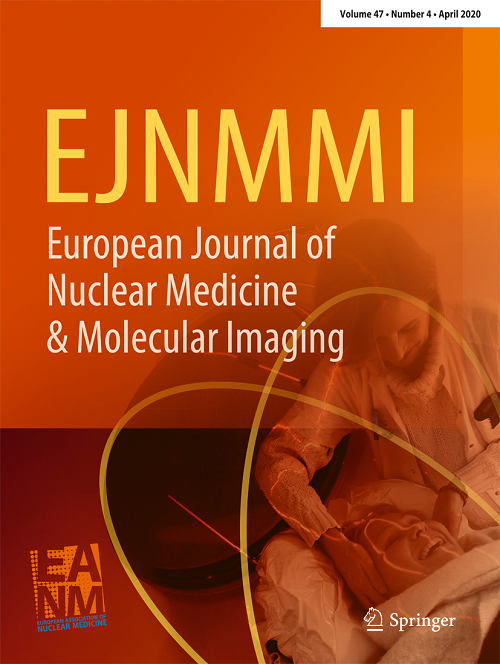Dual-tracer PET/CT with [68Ga]Ga-PSMA-617 and [68Ga]Ga-RM26 improves early prediction of biochemical failure in prostate cancer: a prospective phase II trial.
IF 7.6
1区 医学
Q1 RADIOLOGY, NUCLEAR MEDICINE & MEDICAL IMAGING
European Journal of Nuclear Medicine and Molecular Imaging
Pub Date : 2025-10-03
DOI:10.1007/s00259-025-07574-8
引用次数: 0
Abstract
PURPOSE Prostate-specific membrane antigen (PSMA) and Gastrin-releasing peptide receptor (GRPR) PET demonstrate hopeful results in initial staging of prostate cancer (PCa), offering potential to support precision treatment decisions. We investigated whether the dual-tracer PET/CT with [68Ga]Ga-PSMA-617 and [68Ga]Ga-RM26 could enhance prediction of biochemical recurrence (BCR) after radical prostatectomy (RP) in PCa. METHODS 102 patients from prospective cohort NCT05073653 underwent preoperative [68Ga]Ga-PSMA-617 and [68Ga]Ga-RM26 PET/CT. Tumor uptake was quantified by maximum standardized uptake value (SUVmax), with optimal cutoffs determined using maximally selected rank statistics. Biochemical recurrence-free survival (BRFS) was estimated by Kaplan-Meier analysis, and the correlations between BRFS and predictors were examined using Cox regression. Predictive values were assessed using time-dependent receiver-operating characteristic (ROC) curves. We additionally used transcriptomic data (GSE70770, n = 198) for external validation. RESULTS 52 patients (51.0%) experienced BCR within the follow-up (median, 22.3 months). High PSMA-SUVmax (> 6.6) was associated with shorter BRFS (hazard ratio [HR] 3.17, p = 0.004), as was low GRPR-SUVmax (≤ 13.0) (HR 0.51, p = 0.026). Both were identified as independent predictors for BRFS. PSMA-SUVmax correlated with most of conventional clinicopathological factors (p < 0.005), whereas GRPR-SUVmax did not (p > 0.200). The combined PSMA + GRPR-SUVmax model achieved a superior time-dependent AUC of 0.73, compared with PSMA (AUC 0.63) or GRPR alone (AUC 0.62). External transcriptomic analysis corroborated that PSMAhigh/GRPRlow phenotype was associated with poorer BRFS (p = 0.029). CONCLUSION This study provides first clinical evidence that [68Ga]Ga-RM26 PET/CT adds independent prognostic value to PSMA PET/CT for early prediction of BCR after RP. Dual-tracer PET/CT may enable more accurate risk stratification and guide personalized management in PCa patients.[68Ga]Ga-PSMA-617和[68Ga]Ga-RM26双示踪PET/CT改善前列腺癌生化衰竭的早期预测:一项前瞻性II期试验
前列腺特异性膜抗原(PSMA)和胃泌素释放肽受体(GRPR) PET在前列腺癌(PCa)的初始分期中显示出有希望的结果,为精确治疗决策提供了潜在的支持。我们研究了[68Ga]Ga-PSMA-617和[68Ga]Ga-RM26双示踪PET/CT是否可以增强对前列腺癌根治性前列腺切除术(RP)后生化复发(BCR)的预测。方法前瞻性队列NCT05073653中的102例患者术前接受了[68Ga]Ga-PSMA-617和[68Ga]Ga-RM26 PET/CT检查。肿瘤摄取通过最大标准化摄取值(SUVmax)来量化,并使用最大选择的秩统计确定最佳截止值。采用Kaplan-Meier分析估计生化无复发生存期(BRFS),并采用Cox回归检验BRFS与预测因子之间的相关性。使用随时间变化的受试者工作特征(ROC)曲线评估预测值。我们还使用转录组学数据(GSE70770, n = 198)进行外部验证。结果52例(51.0%)患者在随访期间(中位22.3个月)出现BCR。高PSMA-SUVmax (bbb6.0)与较短的BRFS相关(风险比[HR] 3.17, p = 0.004),低GRPR-SUVmax(风险比≤13.0)与较短的BRFS相关(风险比[HR] 0.51, p = 0.026)。两者均被确定为BRFS的独立预测因子。PSMA-SUVmax与大多数常规临床病理因素相关(p 0.200)。与PSMA (AUC 0.63)或GRPR单独(AUC 0.62)相比,PSMA + GRPR- suvmax联合模型的时间相关AUC为0.73。外部转录组学分析证实PSMAhigh/ grprolow表型与较差的BRFS相关(p = 0.029)。结论本研究首次提供临床证据,证明[68Ga]Ga-RM26 PET/CT为PSMA PET/CT早期预测RP术后BCR增加了独立的预后价值。双示踪剂PET/CT可能使PCa患者的风险分层更准确,并指导个性化管理。
本文章由计算机程序翻译,如有差异,请以英文原文为准。
求助全文
约1分钟内获得全文
求助全文
来源期刊
CiteScore
15.60
自引率
9.90%
发文量
392
审稿时长
3 months
期刊介绍:
The European Journal of Nuclear Medicine and Molecular Imaging serves as a platform for the exchange of clinical and scientific information within nuclear medicine and related professions. It welcomes international submissions from professionals involved in the functional, metabolic, and molecular investigation of diseases. The journal's coverage spans physics, dosimetry, radiation biology, radiochemistry, and pharmacy, providing high-quality peer review by experts in the field. Known for highly cited and downloaded articles, it ensures global visibility for research work and is part of the EJNMMI journal family.

 求助内容:
求助内容: 应助结果提醒方式:
应助结果提醒方式:


